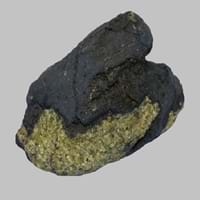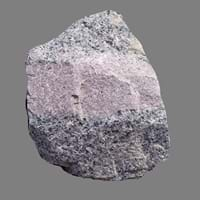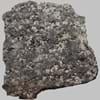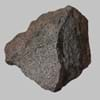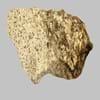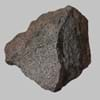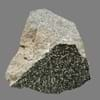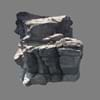Definition
Basanite is a black basaltic rock which mainly contains plagioclase, augite, olivine and nepheline and is formerly used as a touchstone
Aplite is a fine-grained granite composed mainly of feldspar and quartz
Discoverer
Unknown
Unknown
Etymology
From Latin basanites + -ite
From German Aplit, from Greek haploos simple + -ite
Class
Igneous Rocks
Igneous Rocks
Sub-Class
Durable Rock, Hard Rock
Durable Rock, Hard Rock
Group
Not Applicable
Plutonic
Other Categories
Fine Grained Rock, Opaque Rock
Fine Grained Rock, Opaque Rock
Texture
Aphanitic to Porphyritic
Granular, Graphic
Color
Black, Brown, Green, Grey, Red, White
Black, Grey, Orange, Pink, White
Durability
Durable
Durable
Scratch Resistant
Yes
Yes
Appearance
Glassy or Pearly
Veined or Pebbled
Interior Uses
Decorative Aggregates, Homes
Bathrooms, Countertops, Decorative Aggregates, Entryways, Floor Tiles, Homes, Hotels, Kitchens, Stair Treads
Exterior Uses
As Building Stone, Garden Decoration, Office Buildings
As Building Stone, As Facing Stone, Bridges, Paving Stone, Near Swimming Pools, Office Buildings, Resorts
Other Architectural Uses
Whetstones
Curbing
Construction Industry
Arrowheads, Construction Aggregate, Cutting Tool, Spear Points
As Dimension Stone
Medical Industry
Not Yet Used
Not Yet Used
Antiquity Uses
Artifacts, Monuments
Artifacts, Monuments, Sculpture, Small Figurines
Commercial Uses
As a touchstone, Creating Artwork, Gemstone, In fire-starting tools, Manufacture of tools, Metallurgical Flux, Jewelry, To ignite fire, Used in flintlock firearms
Curling, Gemstone, Laboratory bench tops, Small Sculptures, Tombstones
Types
Nepheline-Basanite, Analcite-Basanite and Leucite-Basanite
Not Available
Features
Clasts are smooth to touch, Easily splits into thin plates, Has High structural resistance against erosion and climate, Used as a touchstone
Available in lots of colors, Available in Lots of Colors and Patterns, Is one of the oldest rock
Archaeological Significance
Famous Monuments
Data Not Available
Data Not Available
Sculpture
Not Yet Used
Used
Famous Sculptures
Not Applicable
Data Not Available
Pictographs
Not Used
Not Used
Petroglyphs
Not Used
Not Used
Figurines
Not Yet Used
Used
Formation
Basanite is a fine-grained, hard rock that forms when bits of lava shoot out of volcanoes.
Aplites belong to intrusive igneous rocks which are mostly quart and alkali feldspar and are formed from residual eutectic granitic liquids and represent the final crystallization products of magma.
Mineral Content
Augite, Feldspar, Ilmenite, Olivine, Plagioclase
Amphibole, Biotite, Feldspar, Hornblade, Micas, Muscovite or Illite, Plagioclase, Pyroxene, Quartz
Compound Content
Potassium Oxide, Sodium Oxide, Silicon Dioxide
Aluminium Oxide, CaO, Iron(III) Oxide, FeO, Potassium Oxide, MgO, MnO, Sodium Oxide, Phosphorus Pentoxide, Silicon Dioxide, Titanium Dioxide
Types of Metamorphism
Burial Metamorphism, Cataclastic Metamorphism, Contact Metamorphism, Regional Metamorphism
Burial Metamorphism, Cataclastic Metamorphism, Hydrothermal Metamorphism, Regional Metamorphism
Types of Weathering
Chemical Weathering, Mechanical Weathering
Chemical Weathering, Mechanical Weathering
Types of Erosion
Chemical Erosion, Coastal Erosion, Glacier Erosion, Sea Erosion, Water Erosion, Wind Erosion
Chemical Erosion, Coastal Erosion, Wind Erosion
Grain Size
Fine Grained
Very fine-grained
Fracture
Uneven, Splintery or Conchoidal
Not Available
Porosity
Highly Porous
Less Porous
Luster
Waxy and Dull
Dull to Pearly to Subvitreous
Compressive Strength
Not Available
Cleavage
Non-Existent
Not Available
Toughness
1.5
Not Available
Specific Gravity
2.5-2.8
2.6
Transparency
Translucent to Opaque
Opaque
Density
2.7 g/cm3
2.6 g/cm3
Resistance
Heat Resistant, Impact Resistant, Pressure Resistant, Wear Resistant
Heat Resistant, Wear Resistant
Deposits in Eastern Continents
Asia
Not Yet Found
China, India, Iran, Saudi Arabia, Sri Lanka, Taiwan, Thailand, Turkey, Vietnam
Africa
Uganda
Angola, Egypt, Madagascar, Namibia, Nigeria, South Africa
Europe
Germany, Hungary, Italy, Spain
Austria, Belgium, Finland, France, Germany, Italy, Norway, Sardinia, Spain, Switzerland, The Czech Republic, Venezuela
Others
Greenland, Mid-Atlantic Ridge
Not Yet Found
Deposits in Western Continents
North America
USA
Canada, USA
South America
Bolivia, Brazil
Not Yet Found
Deposits in Oceania Continent
Australia
New South Wales, New Zealand, Queensland, South Australia, Western Australia
Not Yet Found
All about Basanite and Aplite Properties
Know all about Basanite and Aplite properties here. All properties of rocks are important as they define the type of rock and its application. Basanite and Aplite belong to Igneous Rocks.Texture of Basanite is Aphanitic to Porphyritic whereas that of Aplite is Granular, Graphic. Basanite appears Glassy or Pearly and Aplite appears Veined or Pebbled. The luster of Basanite is waxy and dull while that of Aplite is dull to pearly to subvitreous. Basanite is available in black, brown, green, grey, red, white colors whereas Aplite is available in black, grey, orange, pink, white colors. The commercial uses of Basanite are as a touchstone, creating artwork, gemstone, in fire-starting tools, manufacture of tools, metallurgical flux, jewelry, to ignite fire, used in flintlock firearms and that of Aplite are curling, gemstone, laboratory bench tops, small sculptures, tombstones.
